Hawker Sea Hurricane Mk.IIC
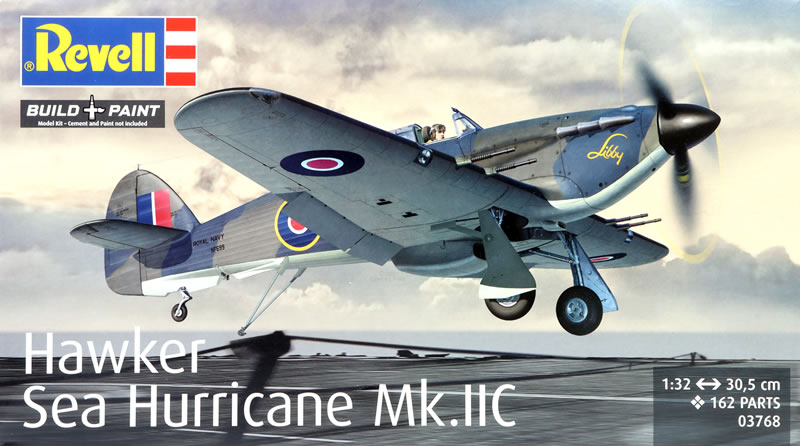
Revell,
1/32 scale
S
u m m a r y : |
Description and Item No.: |
Revell Kit No. 03768 - Hawker Sea Hurricane Mk.IIC |
Contents and Media: |
147 parts in pale grey plastic (13 parts not used); 13 parts in clear plastic; markings for two aircraft; detailed illustrated instructions. |
Price: |
GBP£44.99 EU Price (£37.49 Export Price) Plus Shipping at Hannants |
Scale: |
1/32 |
Review Type: |
First Look |
Advantages: |
Convincing surface textures including stretched fabric effect; high level of detail; dropped or raised flaps included; separate control surfaces; includes Vokes tropical filter; alternative parts for open or closed canopy; perfectly printed decals; good outline and detail accuracy. |
Disadvantages: |
Some ejector pin circles may be visible in cockpit. |
Recommendation: |
Revell’s 1/32 scale Sea Hurricane Mk.IIC takes the same approach as their other recent 1/32 releases - sensible engineering, no gimmicks, nice surface textures, good level of detail straight from the box and by all reports so far, good fit.
All the parts required to build a non-navalised Hurricane Mk.IIC are in the box too, including one of the decal options.
On the other hand the pale plastic obscures some of the surface textures, but it will all look good under paint.
Revell's big Hurricane is not a "super kit". It does not feature an engine nor full interior detail. Models like this do, however, fulfil an important role as an "everymodeller" kit - a straightforward build at a reasonable price.
These kits are worthy successors to the classic 1/32 scale Revell kits of the 1960s. I am very pleased that Revell has added the Sea Hurricane to their list of new tool projects. |
Reviewed by Brett Green

Background
The Hawker Hurricane was Britain's first modern monoplane fighter aircraft, entering service in 1937.
Hawker's chief designer, Sidney Camm, designed the Hurricane around the new Rolls-Royce Merlin engine. Although the British Air Ministry had not yet placed an order, Hawker nevertheless prepared for the production of 1,000 aircraft. This head start significantly expedited delivery once the order for 600 Hurricanes was received in June 1936.
In addition to the fabric covered rear fuselage, the earliest versions of the Hurricane featured fabric wings, reflecting the earlier production techniques of the Hawker Aircraft Company. These initial 600 aircraft were also fitted with a fixed pitch, two-bladed wooden Watts propeller, although these were quickly supplanted by de Havilland and Rotol three-bladed propeller assemblies that permitted pitch adjustment from the cockpit. The later improved aircraft also included windscreens with armoured glass. In time, the fabric wings of many of these early Hurricanes were replaced with metal wings.
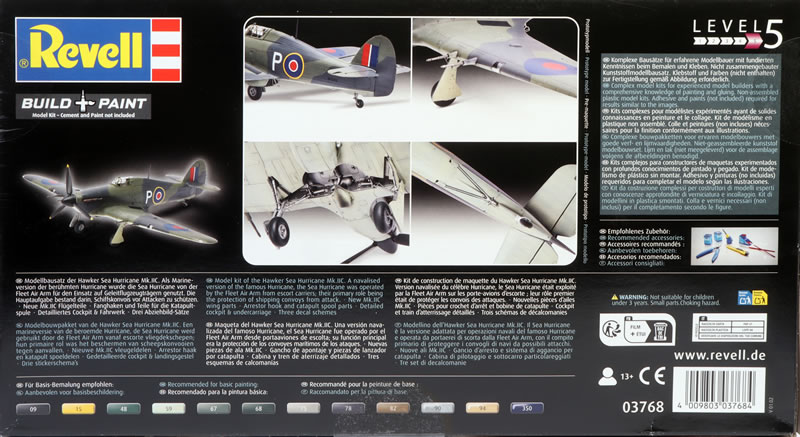
Although the Hurricane could absorb an enormous amount of punishment and could out-turn the Messerschmitt Bf 109 (and even the Spitfire) it was a slower aircraft. In the air war over France, the Bf 109 E showed itself to be somewhat superior to the Hurricane, especially those fitted with the two-bladed Watts propeller, but the British fighter had the edge over the prestigious twin-engined Bf 110. During the Battle of Britain, the Hurricane’s main role was to engage Luftwaffe bombers, with Spitfires tackling the more nimble German fighters. Although the fabric wing was largely phased out by this time, there were still examples of the type in use over England in that fateful summer of 1940.
Less glamorous than its legendary stablemate, the Hawker Hurricane was nevertheless a key factor in the RAF's victory in the Battle of Britain.
Hurricane Mk.IIC
The Hurricane Mk II armed with four 20 mm (.79 in) Hispanos became the Mark IIC,using a slightly modified wing. Trials with a pair of external cannons as armament had begun in May 1939, then the internal arrangement in June to August 1940.
In November 1940 thirty sets of Hurricane IIC (four cannon) wings were built by semi-tooled and hand methods in the experimental shop, using wings damaged in the region of the gun bay.

Test flights with external fuel tanks began in May 1940, the first Mark II trials in June 1941. Test flights carrying bombs began in April 1941, the first Mark II trials with 500-pound bombs were in February 1942, most Mark II were built as able or converted to carry external stores. By then performance was inferior to the latest German fighters, and the Hurricane changed to the ground-attack role, sometimes referred to as the Hurribomber.
The Mk.II also served as a night fighter and "intruder." The last Hurricane built was a Mark IIC, serial number PZ865.
Sea Hurricane Mk.IIC
The Hurricane Mk IIC version equipped with catapult spools, an arrester hook and full naval avionics. Around 60 were built by Hawker November 1942 to May 1943, around another 50 Mk IIB were converted, with most receiving C wings. The Merlin XX engine on the Sea Hurricane generated 1,460 hp at 6,250 ft (1,900 m) and 1,435 hp at 11,000 ft (3,400 m). Top speed was 322 mph (518 km/h) at 13,500 ft (4,100 m) and 342 mph (550 km/h) at 22,000 ft (6,700 m).
Revell released their all-new 1/32 scale Hawker Hurricane Mk.IIb kit in late 2022. They have now expanded the family with a 1/32 scale Sea Hurricane Mk.IIC
Revell's 1/32 scale Sea Hurricane Mk. IIC comprises 147 parts in pale grey plastic (eight parts not used), 13 parts in clear plastic, markings for three aircraft and detailed illustrated instructions.
All the parts required to build a non-navalised Hurricane Mk.IIC are in the box too, including one of the decal options.
The sprues are named A, B, C, D, E, F, G and the clear sprue J. These are the same sprue names as the previous Hurricane Mk.IIB but there are some changes. Sprues C and D, the wing sprues, are all new. Sprues F, G and I have been modified too.
Surface detail is very nice. Recessed fine panel lines are supplemented by subtle stretched fabric effect on the mid to rear fuselage, the wings and the tail planes. Fasteners are depicted by circles on the engine cowling and fuselage. The overall impact is restrained and impressive.
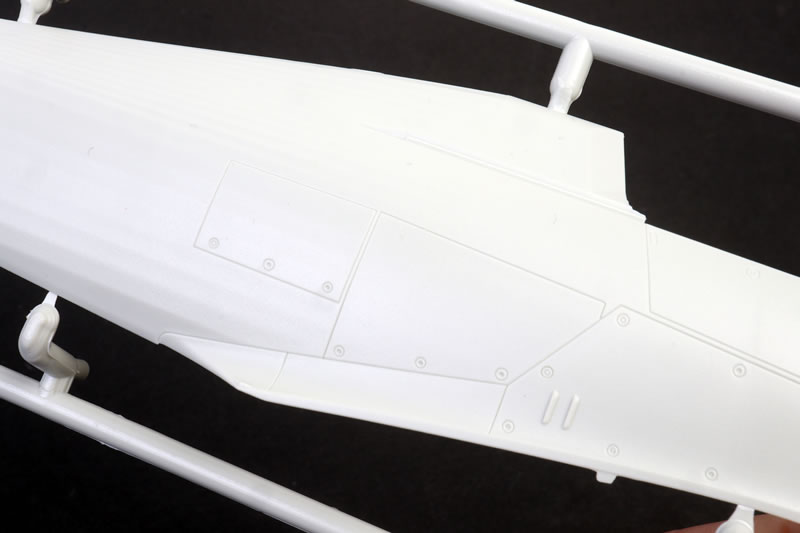
On the other hand the pale plastic obscures some of the surface textures, but it will all look good under paint.
There are also a number of recessed ejector pin circles on the inside of the fuselage. These will be partly hidden by the layers of cockpit frame detail but might be worth filling and sanding prior to assembly.
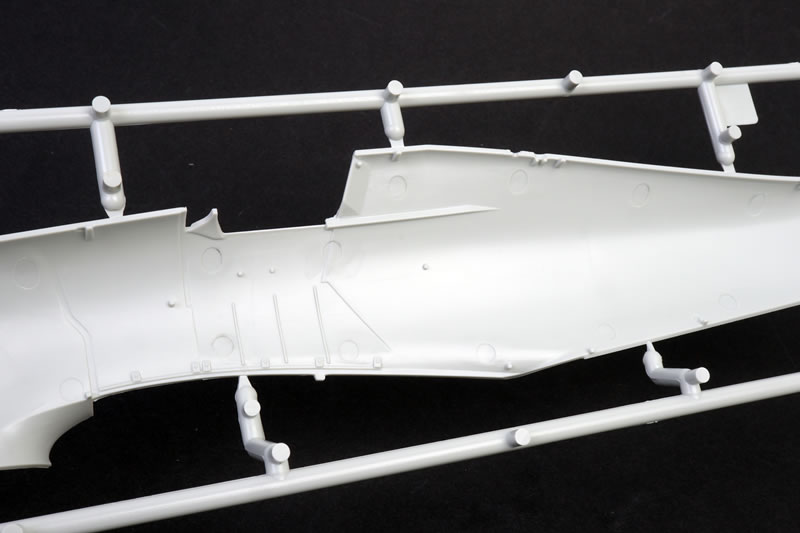
Interior detail is very nice. The cockpit's surrounding Warren girder-type fuselage interior of high-tensile steel tubes, frames and longerons is well depicted.
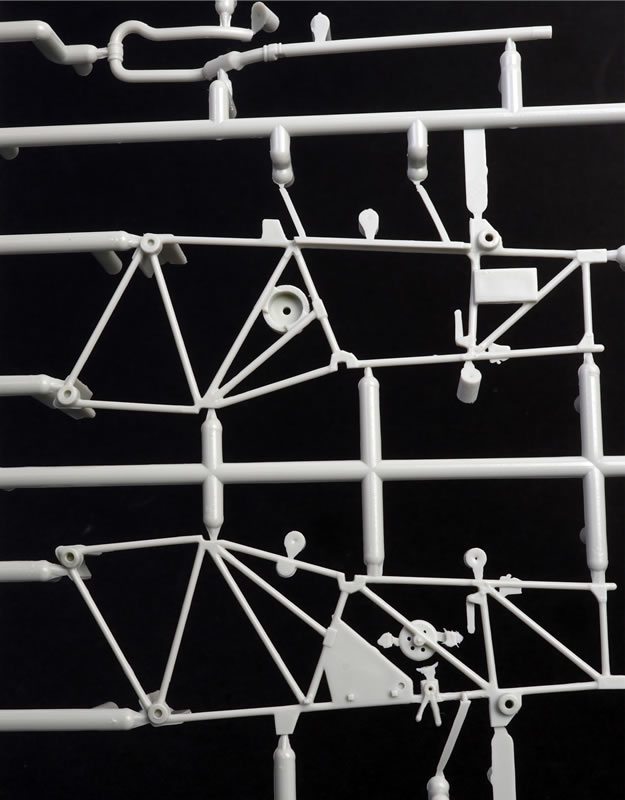
The seat is made up from four parts but no harness is supplied.
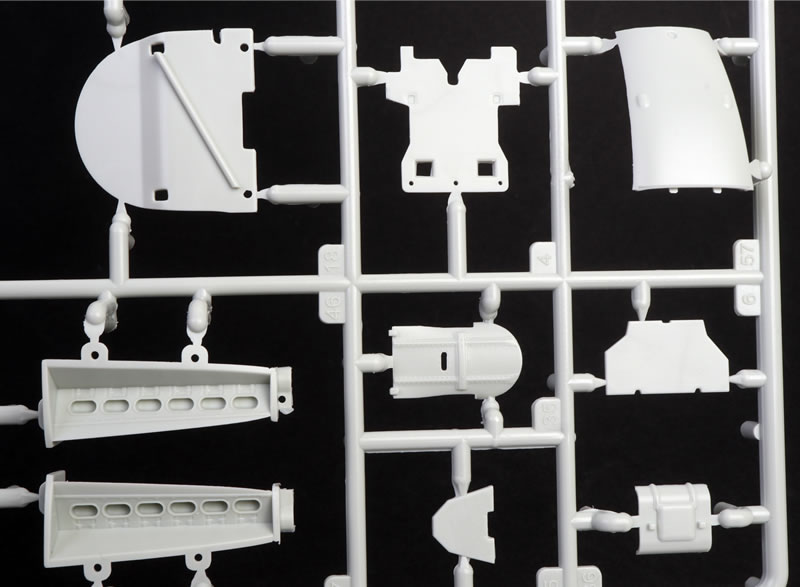
The port sidewall features a map case, paired on the starboard side with a console perched on tubular framing.
The bottomless cockpit floor with its distinctive footrails looks good too.
The instrument panel features raised bezels and switches that should respond well to painting and dry brushing. Decals are supplied as an alternative finish for the instrument panel.
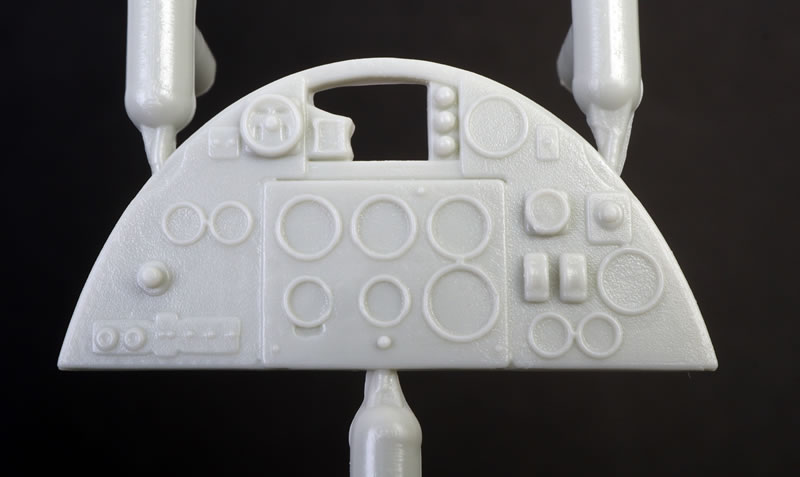
The wings are presented as upper and lower left and right halves, with a separate middle-lower section. The wings are held in place with stout tabs and a short wing spar. Take care to ensure that the correct dihedral is set for the wings. The angle of incidence was 2° 0′, and the outer wing panels had 3° 30′ dihedral.
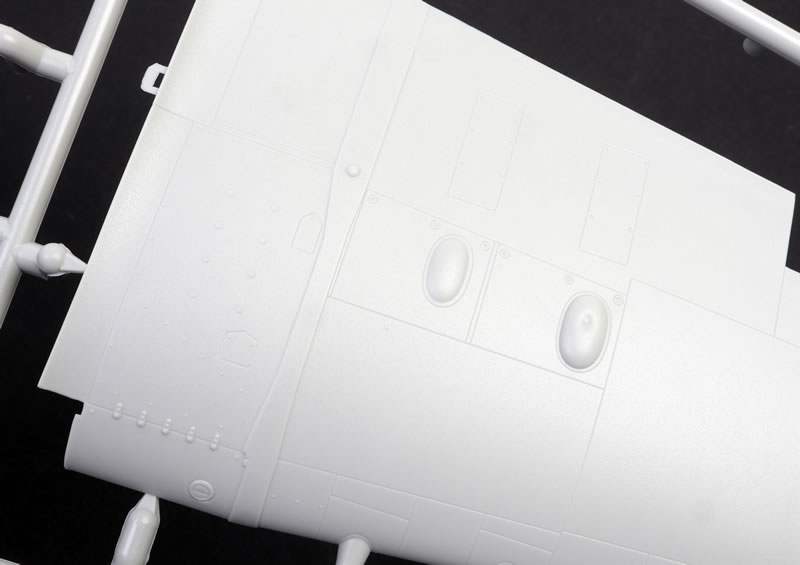
The main undercarriage bay is built inside the lower mid-wing section. Detail looks great
Control surfaces are separate parts and may be posed to taste. Two sets of optional parts are supplied so the flaps may be posed dropped or retracted. This is a nice easy approach whether you plan to build your flaps up or down.
Landing lights and the outboard machine guns are inserts for the leading edges of the wings.
All the parts required to build a Hurricane Mk.IIC in the box including decals.
There is even a three-part Vokes filter on the sprues if you have markings for a tropical Mk.IIc.
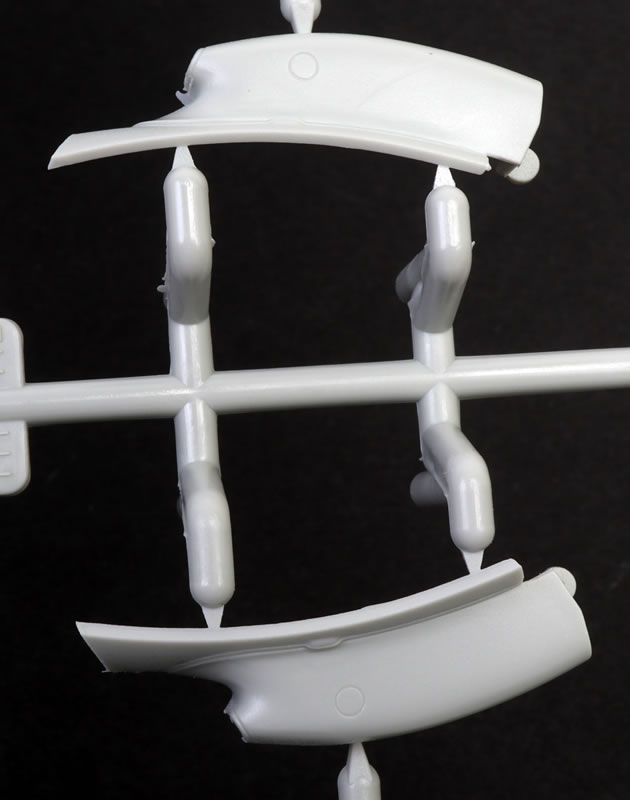
Two styles of cowl ring are offered. Check the instructions to see which fits where. Other optional parts include two styles of exhaust, alternative mirrors and raised or lowered pilot's entry step.
The clear parts are thinly moulded and good looking in shape. Revell has supplied different parts for the open and closed canopy - single part for closed and two pieces for open.
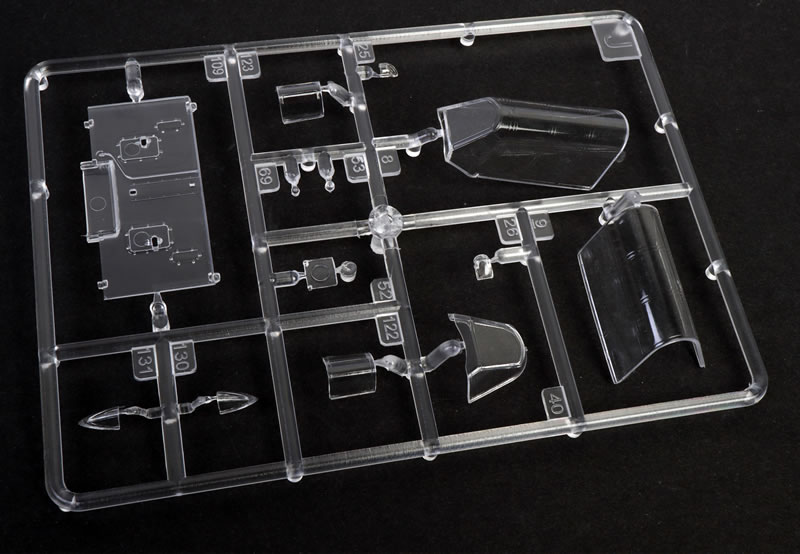
Engineering and parts breakdown is conventional.
The overall profile and plan form looks accurate.
Markings
Markings are supplied for two Sea Hurricane Mk.IIC and one Hurricane Mk.IIC.

Decals are glossy in finish.
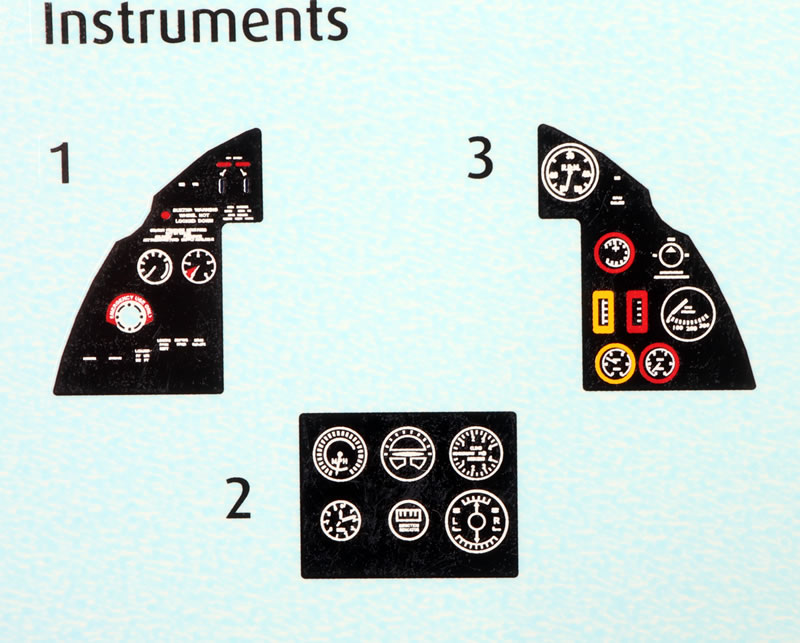
Stencils and instrument dials are included on the sheet.
Revell’s 1/32 scale Sea Hurricane Mk.IIC takes the same approach as their other recent 1/32 releases - sensible engineering, no gimmicks, nice surface textures, good level of detail straight from the box and by all reports so far, good fit.
This one also has the bonus of also being able to be built as a non-navalised Hurricane Mk.IIC.
On the other hand the plastic does the kit no favours. The very pale shade obscures some of the surface textures, but it should all look good under paint. Revell's big Hurricane is not a "super kit". It does not feature an engine nor full interior detail.
Models like this do, however, fulfil an important role as an "everymodeller" kit - a straightforward build at a reasonable price. These kits are worthy successors to the classic 1/32 scale Revell kits of the 1960s.
I am very pleased that Revell has added the Sea Hurricane to their list of new tool projects.
Purchased by Reviewer
Review Text and Images Copyright © 2025 by Brett Green
Page Created 21 August, 2025
Last updated
7 October, 2025
Back to HyperScale Main Page
Back to Reviews Page

|
Home
| What's New |
Features |
Gallery |
Reviews |
Reference |
Forum |
Search